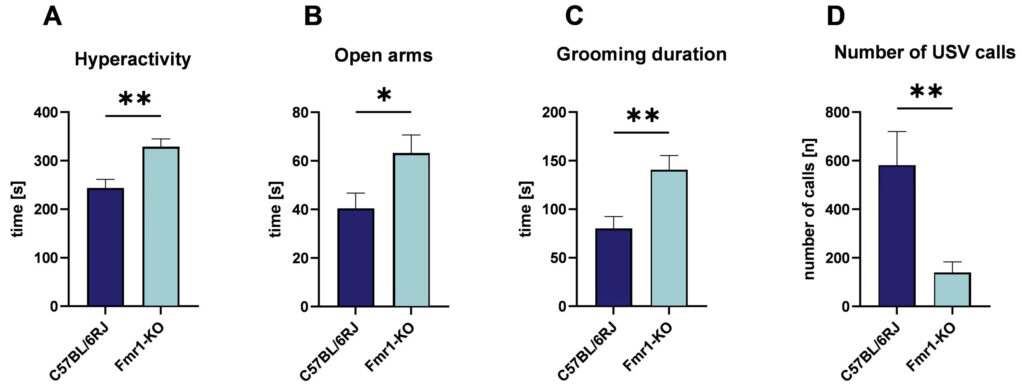Fragile X syndrome (FXS) is a monogenic cause of autism spectrum disorder (ASD) and the most inherited form of intellectual disability. Silencing FMR1 gene with more than 200 CGG repeats causes lack of the fragile X mental retardation protein 1 (FMRP). The Fmr1-knockout (KO) mouse model is a well-known model to study FXS and ASD and presents symptoms of social deficits and repetitive behaviors. In addition, phenotypic traits such as hyperactivity and altered anxiety are observed in this mouse model.
The most important behavioral abnormalities observed in Fmr1-KO mice are:
- Increased repetitive behavior of autogrooming
- Altered anxiety
- Social deficits
- Hyperactivity
Analysis of the behavior of Fmr1-KO mice revealed hyperactivity (A), altered anxiety (B), increased repetitive behavior as shown by autogrooming (C), as well as social communication deficit (D).

Figure 1: Hyperactivity, altered anxiety, auto-grooming, and social deficits of male Fmr1-KO mice at the age of 7-10 weeks. Hyperactivity measured by open field test (A), increased anxiety measured by elevated plus maze test (B), increased repetitive behavior (C) measured by the time spent self-grooming in the auto-grooming test, and social deficits (D) measured by the ultrasonic vocalization test in male Fmr1-KO compared to C57BL/6JRJ mice. n = 15 per group. Unpaired t-test; mean + SEM; *p<0.05, **p<0.01.
Our results confirm that of others showing that Fmr1-KO mice display the most common symptoms of fragile X syndrome and ASD such as social deficits, repetitive behavior, hyperactivity, and altered anxiety and thus are a valuable tool to study both disorders.
Scantox offers a custom-tailored study design for Fmr1-KO mice, and we are flexible to accommodate to your special interests. We are also happy to advice you and propose study designs. Animals will be purchased right after your order Fmr1-KO mice show relevant features of fragile X syndrome already at young age. This allows for extraordinarily fast processing times. Furthermore, C57BL/6 mice are available as control animals needed for proper study design.
We are happy to evaluate the efficacy of your compound in the Fmr1-KO mouse model! The most common readouts are:
